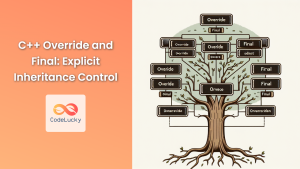In the world of C++, inheritance is a powerful feature that allows developers to create new classes based on existing ones. However, when it comes to constructors, things can get a bit tricky. That's where inheriting constructors come into play, and the using Base::Base syntax becomes a game-changer. In this comprehensive guide, we'll dive deep into the concept of inheriting constructors in C++, exploring how they work, when to use them, and how they can simplify your code.
Understanding Inheriting Constructors
Inheriting constructors is a feature introduced in C++11 that allows a derived class to inherit the constructors from its base class. This can significantly reduce boilerplate code and make class hierarchies more manageable.
🔑 Key Concept: Inheriting constructors enables a derived class to use the constructors of its base class without explicitly declaring them.
Let's start with a simple example to illustrate the problem that inheriting constructors solve:
class Base {
public:
Base(int x) : value(x) {}
Base(const std::string& s) : name(s) {}
private:
int value;
std::string name;
};
class Derived : public Base {
public:
// Without inheriting constructors, we need to declare these:
Derived(int x) : Base(x) {}
Derived(const std::string& s) : Base(s) {}
};
In this example, we have to explicitly declare constructors in the Derived class that simply forward their arguments to the Base class constructors. This can become tedious and error-prone, especially when the base class has many constructors.
Enter using Base::Base
C++11 introduced a simpler way to inherit constructors using the using declaration:
class Derived : public Base {
public:
using Base::Base; // Inherit all constructors from Base
};
With this single line, Derived now inherits all the constructors from Base. This means we can create Derived objects using any constructor defined in Base, without having to redeclare them in Derived.
🚀 Pro Tip: Inheriting constructors can significantly reduce the amount of boilerplate code in your derived classes, making them easier to maintain and less prone to errors.
How Inheriting Constructors Work
When you use using Base::Base, the compiler generates a set of forwarding constructors in the derived class. These constructors have the same parameters as the base class constructors and simply forward the arguments to the base class.
Let's look at a more detailed example to see how this works in practice:
#include <iostream>
#include <string>
class Vehicle {
public:
Vehicle(int wheels) : numWheels(wheels) {
std::cout << "Vehicle with " << numWheels << " wheels constructed." << std::endl;
}
Vehicle(const std::string& name) : vehicleName(name) {
std::cout << "Vehicle named " << vehicleName << " constructed." << std::endl;
}
Vehicle(int wheels, const std::string& name) : numWheels(wheels), vehicleName(name) {
std::cout << "Vehicle " << vehicleName << " with " << numWheels << " wheels constructed." << std::endl;
}
private:
int numWheels;
std::string vehicleName;
};
class Car : public Vehicle {
public:
using Vehicle::Vehicle; // Inherit all constructors from Vehicle
};
int main() {
Car car1(4);
Car car2("Sedan");
Car car3(4, "SUV");
return 0;
}
Output:
Vehicle with 4 wheels constructed.
Vehicle named Sedan constructed.
Vehicle SUV with 4 wheels constructed.
In this example, the Car class inherits all constructors from the Vehicle class. We can create Car objects using any of the Vehicle constructors without having to redeclare them in the Car class.
Advantages of Inheriting Constructors
- Reduced Code Duplication: You don't need to write forwarding constructors in the derived class.
- Automatic Updates: If you add or modify constructors in the base class, the derived class automatically inherits these changes.
- Improved Maintainability: Less code means fewer opportunities for errors and easier maintenance.
Limitations and Considerations
While inheriting constructors can be very useful, there are some limitations and considerations to keep in mind:
-
No Customization: Inherited constructors can't be customized. If you need to add additional logic in the derived class constructor, you'll need to declare it explicitly.
-
Inheritance of All Constructors: When you use
using Base::Base, you inherit all public and protected constructors. You can't selectively inherit only some constructors. -
Potential Name Hiding: If the derived class has any constructor with the same signature as a base class constructor, it will hide the inherited constructor.
Let's look at an example that demonstrates these limitations:
#include <iostream>
#include <string>
class Animal {
public:
Animal(const std::string& name) : animalName(name) {
std::cout << "Animal " << animalName << " constructed." << std::endl;
}
Animal(int age) : animalAge(age) {
std::cout << "Animal of age " << animalAge << " constructed." << std::endl;
}
protected:
std::string animalName;
int animalAge;
};
class Dog : public Animal {
public:
using Animal::Animal; // Inherit all constructors from Animal
// This constructor will hide the inherited constructor with the same signature
Dog(const std::string& name) : Animal(name) {
std::cout << "Dog " << animalName << " constructed with custom logic." << std::endl;
}
// We can't customize the inherited int constructor without redeclaring it
// Dog(int age) : Animal(age) { ... } // This would be necessary for customization
};
int main() {
Dog dog1("Buddy"); // Uses the custom Dog constructor
Dog dog2(3); // Uses the inherited Animal constructor
return 0;
}
Output:
Animal Buddy constructed.
Dog Buddy constructed with custom logic.
Animal of age 3 constructed.
In this example, the Dog class inherits constructors from Animal, but also defines its own constructor for the string parameter. This custom constructor hides the inherited one with the same signature.
Best Practices for Using Inheriting Constructors
To make the most of inheriting constructors, consider these best practices:
-
Use When Appropriate: Inherit constructors when you want the derived class to have the same construction behavior as the base class.
-
Combine with Default Arguments: You can use default arguments in the base class constructors, which will be inherited by the derived class.
-
Be Aware of Hiding: If you need to customize a specific constructor, be aware that it will hide the inherited version.
-
Document Clearly: Make sure to document that your class is inheriting constructors, as it might not be immediately obvious to other developers.
Here's an example incorporating these best practices:
#include <iostream>
#include <string>
class Shape {
public:
Shape(double s = 1.0) : size(s) {
std::cout << "Shape constructed with size " << size << std::endl;
}
Shape(const std::string& c, double s = 1.0) : color(c), size(s) {
std::cout << "Shape constructed with color " << color << " and size " << size << std::endl;
}
protected:
std::string color;
double size;
};
class Circle : public Shape {
public:
// Inherit all constructors from Shape
using Shape::Shape;
// Custom constructor for radius
Circle(double radius) : Shape(radius * 2) {
std::cout << "Circle constructed with radius " << (size / 2) << std::endl;
}
};
int main() {
Circle c1; // Uses inherited default constructor
Circle c2(2.5); // Uses custom Circle constructor
Circle c3("Red"); // Uses inherited color constructor
Circle c4("Blue", 3.0); // Uses inherited color and size constructor
return 0;
}
Output:
Shape constructed with size 1
Shape constructed with size 5
Circle constructed with radius 2.5
Shape constructed with color Red and size 1
Shape constructed with color Blue and size 3
This example demonstrates how inheriting constructors can be combined with custom constructors and default arguments to create a flexible and intuitive interface for derived classes.
Conclusion
Inheriting constructors using the using Base::Base syntax is a powerful feature in C++ that can significantly simplify your code when working with class hierarchies. By allowing derived classes to automatically inherit constructors from their base classes, you can reduce code duplication and improve maintainability.
However, it's important to use this feature judiciously and be aware of its limitations. When you need custom logic in derived class constructors or want to selectively inherit only certain constructors, you may need to fall back to explicitly declaring constructors in the derived class.
By understanding how inheriting constructors work and following best practices, you can write more efficient and maintainable C++ code, leveraging the full power of object-oriented programming.
Remember, the key to mastering C++ is practice and experimentation. Try incorporating inheriting constructors into your next project and see how they can simplify your class hierarchies!


















